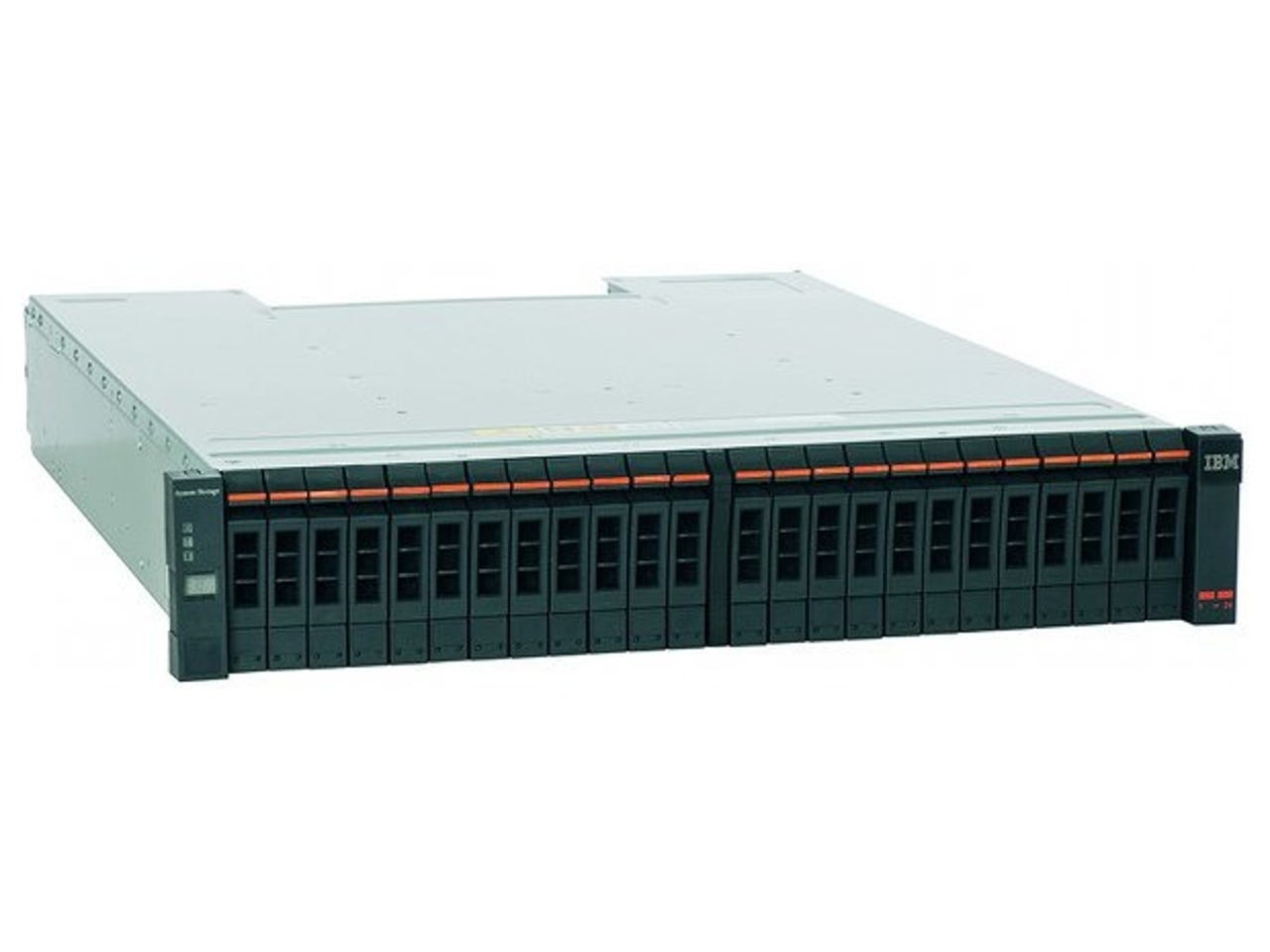IBM Storwize V7000


IBM Storwise V7000
Under the hood, the Storwize V7000 is built from technologies originally developed for IBM's enterprise-class storage systems, so the V7000 benefits from a comprehensive set of high-end features that have been scaled down for mid-range buyers.
On the front of the compact 2U rack-mount chassis there's space for up to 24 Serial Attached SCSI (SAS) hard drives. Other drive options include 2TB 3.5in. and 600GB 2.5in. SAS disks. Our review unit was fitted with 22 2.5in. 300GB drives spinning at 10,000rpm and two enterprise-class 2.5in. 300GB SSD drives, giving us an array of 5.2TB formatted capacity. The Storwize V7000's £113,853 price as reviewed looks startling, but the (E-MLC) SSD drives take up a fair chunk of that at £21,427 each. Also, these are list prices and discounts will often be available from IBM's distribution partners.
At the back of the chassis were two battery-backed load balancing power supplies and two RAID controllers. Each controller had 8GB of cache RAM, plus two Gigabit LAN ports, both of which can be used for iSCSI. There were also four 8Gbps Fibre Channel ports and two USB ports, plus SAS expansion ports for daisy-chaining to other Storwize disk enclosures.
So if 24 drives isn't enough, the system could be fitted with a maximum of 240 drives by daisy-chaining additional Storwize units.
Initial configuration couldn't be simpler. Setup software is supplied on a 2GB USB memory stick, which must be used with a computer running Windows XP or above. The software is set to autorun, and in our lab tests it enabled us to sort out basic settings such as the unit's IP address. Once this information was stored on the USB drive, all we needed to do was place the USB drive into a slot on the Storwize V7000 and the information was automatically transferred to the array.
After initial configuration using software supplied on a USB stick, setup and management for the Storwize V7000 is carried out via a graphical web-based management console
From this point forward, pretty much all other configuration is done using a web browser connected to the Storwize array. The first time we connected with our browser a setup wizard asked us to accept the software licence and configure the unit's name, time zone and email settings so it could 'phone home' in case of problems. The wizard then attended to other chores, such as configuring the disks into RAID groups. We took the 'recommended configuration' option, which used all the available disks to create four MDisks (Managed Disks). Three were RAID 5 arrays of seven hard drives each, while the fourth used the two SSDs to make a mirrored pair. The wizard then placed the four MDisks into an MDisk group, and any volumes we subsequently created were placed in this Mgroup and spanned the three RAID 5 MDisks. As we'd chosen the recommended settings option, the setup wizard allocated the mirrored SSD disks for use by Easy Tier.
The setup wizard configured four MDisks: three seven-drive RAID 5 arrays and a pair of mirrored SSDs
Easy Tier originated in the high-end IBM Storage System DS8000, and boosts performance by automatically moving data from the relatively slow hard disks to the lightning-fast SSDs. Easy Tier looks at data usage over a 30-day period to determine which data would benefit most from being moved.
Finally the wizard gave us the option to migrate data from external SAN storage onto the Storwize array. The wizard could handle most types of storage, but it couldn't import SAN boot images or storage attached to clustered hosts, including VMware ESX servers. Server operating systems make a few restrictions affecting migration — for example, all I/O to storage being migrated must be stopped during migration. But the V7000 makes the migration process fairly unobtrusive. For example, once the storage has been stopped it could be mapped to the V7000 and then re-presented to the host. This done, the host could continue to use the data even while it's being migrated.
After the setup wizard had finished, we used the web-based management interface to create volumes and allocate them to hosts. The management GUI is another feature imported from IBM's enterprise storage products — in this case from the IBM XIV Storage System.
We really liked the layout and functionality of the GUI. For example, the Suggested Tasks drop-down offered a quick link to the 'Create volume' option, where we could make volumes and assign them to our hosts.
The Storwize V7000 can use thin-provisioning to create huge volumes without wasting unused disk space
Although the V7000 can use thin-provisioning to create huge volumes without wasting unused disk space, it does not currently work with VMware's VAAI (vStorage APIs for Array Integration). However, this support is expected to be added in the next firmware release, and will make the V7000 a good choice for organsations running VMware servers.
As well as the migration option mentioned earlier, the Storwize V7000 can also virtualise existing third-party SAN disk arrays so they are managed from the Storwize V7000's GUI. Besides providing simpler management, virtualising existing storage is likely to simplify SAN setup and increase the overall utilisation of those older storage resources, which could help delay the purchase of new disks.
In case of mains power failure, the batteries in the power supplies are designed to provide enough power to gracefully shut down the V7000. When fully charged, the batteries have enough power to perform three such shutdowns. When they are flat, the V7000 will function in cache write-though mode.
A few high-end features are absent from the V7000. In particular, you'll need to buy additional hardware if you want to dedupe your storage system or compress data in flight.